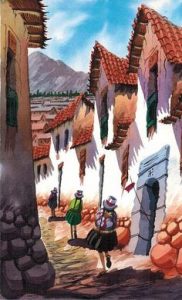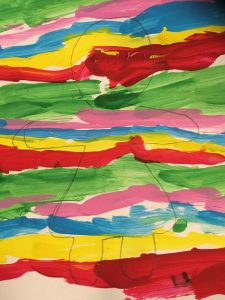Strategy#1 : See-Think-Wonder
Age group of children: 3-4 years (preschool age)
Ohio Department of Education Early Learning Standards:
Strand: Geography
Topic:Spatial Thinking and Skills
STANDARD STATEMENT Demonstrate a beginning understanding of maps as actual representations of places.
Strand:Listening & Speaking
Topic: Expressive Language
STANDARD STATEMENT Use language to communicate in a variety of ways with others to share observations, ideas and experiences; problem-solve, reason, predict and seek new information.
Strand:Creativity
Topic:Innovation and Invention
Standard Statement: Use imagination and creativity to interact with objects and materials.
Strand:Creativity
Topic:Expression of Ideas and Feelings Through the Arts
STANDARD STATEMENT
Express interest in and show appreciation for the creative work of others
General Unit Theme: The curriculum at La Casita Learning Center is focused on different Spanish Speaking Countries and Cultures throughout the summer. Different age children at the center have varying abilities to understand the concept of place or location.
Guiding Questions for Unit:
What does place or location mean? This concept is developed with young children by first beginning with their personal places and locations. Home, school etc.
How can people represent objects within their place or location? ART – PAINTING WITH WATERCOLORS
Materials: Watercolor Pictures, Art Easels, Watercolors, Paint brushes
Step 1: Ask the children what art is and record their responses. Ask the children how people “do” art and record their responses. Give examples as needed to get the children thinking. Then talk with the children about what people try to show with their art. Give examples.
Step 2: Show children pictures of watercolor art from Guatemala. Show children where Guatemala is on the globe and where we are in relation to Guatemala.
Tell the children these are watercolor paintings by people who live in Guatemala.
Ask the children to spend 3 minutes looking at the pictures Ask them to describe what they see the artists from Guatemala are trying to show with their watercolor art; “Yo veo……….” Generate a list of what the children say.





Step 2 Sit in a semicircle with paintings displayed and ask children to tell them what seeing the pictures makes them think of. Use open discussion.
Step 3 Describe and model what the word “wonder” means and then ask the kids what seeing the pictures and thinking about the pictures makes them wonder. Use open discussion.
Step 4 Model “I wonder what I could represent by painting in watercolors?” by showing the last couple strokes of a painting completed by teacher.
Step 5 Ask the children to think of something they would like to represent by painting in watercolors. Then have them close their eyes to try to see what it would look like.
Step 6 Each child has set of watercolors and paper to begin painting.
Take a look at our Artistas with this lesson.
https://www.facebook.com/lacasitalanguagecenter/?hc_ref=PAGES_TIMELINE
Step 7 Instructor asks the children to describe what they are painting and then when finished they share with the others.
Evaluation: Formative – Did the child paint with watercolors? Was he/she able to express what his/her drawing represented to peers and teacher?
Strategy #2 – CSI: COLOR, SYMBOL, IMAGE
Age group of children: 8-10 years (3rd-5th grade)
General Unit Theme: Spanish Speaking Countries/Cultures
Ohio Learning Standards Grade 3 – Social Studies
Theme: Communities: Past and Present, Near and Far
Strand: Geography
Topic: Places and Regions
A place is a location having distinctive characteristics, which give it meaning and character and distinguish it from other locations. A region is an area with one or more common characteristics, which give it a measure of homogeneity and make it different from surrounding areas. Regions and places are human constructs.
Topic:Spatial Thinking and Skills
Spatial thinking examines the relationships among people, places and environments by mapping and graphing geographic data. Geographic data are compiled, organized, stored and made visible using traditional and geospatial technologies. Students need to be able to access, read, interpret and create maps and other geographic representations as tools of analysis.
Materials: Maps, Books on Guatemala, Chart Paper, Various drawing tools (crayons, colored pencils, markers)
Guiding Questions & Steps for Lesson:
Step One:What does place or location mean? Ask the children to find Guatemala on their maps and go to the globe to show where Guatemala is located in relation to Ohio.
Step Two: How do people interact with their families within their place or location? How is this similar or different to the way you interact with your family? Show the picture of a Guatemalan family. Ask students to think about what they see in this family. Write what they say on whiteboard. (This is 1 representation of 1 Guatemalan family. Families are very diverse in Guatemala and this is very important for the children to know up front.)

Step Two: Choose a symbol that reflects a similarity you feel your family has with this family. Ask the children to draw the symbol.
Step Three: Choose a symbol that reflects a difference you feel your family has with this family. Ask the children to draw the symbol.
Step Four: Partner the children and ask them to take a look at the symbols they chose for similarities and differences. Ask them to guess what each of their partner’s symbols represent and then share the artist’s meanings after partners have had time to guess.
Evaluation: Formative = Is the child able to locate Guatemala on the map and show where it is in relation to Ohio? Did the child choose one symbol to represent a similarity and one symbol to represent a difference? Did the child have discussion with his/her partner and did he/she guess what the other’s symbol represented?

Carey – Owen about injury of varese, said it happened out how knight players want to play games.”I was about to enter a 5 on 5 game, but after three seconds, varese is injured
Nike CR7 Cleats
Hi, i believe that i noticed you visited my weblog so i came to “go back the want”.I’m attempting to in finding things to improve my site!I assume its adequate to use a few of your ideas!!
lebron james shoes
What stood out on Game Rewind was Brown’s impressive leaping ability, great ball skills and sure hands.
NFL Jerseys Cheap China
Carey – Owen about injury of varese, said it happened out how knight players want to play games.”I was about to enter a 5 on 5 game, but after three seconds, varese is injured
puma suede
I really enjoy studying on this web site, it holds fantastic blog posts.
Atlanta Falcons: WR Julio Jones (calf) Jones told reporters Saturday that he expects to play Monday.
Nike NFL Jerseys China
Prince – MTV Stategies | EDT 622
deegxkeizh http://www.gc542g7q2a4j1esr9x4r6yg23i98o5r0s.org/
adeegxkeizh
[url=http://www.gc542g7q2a4j1esr9x4r6yg23i98o5r0s.org/]udeegxkeizh[/url]
Beth, Isn’t teaching art a beautiful thing? The watercolor activity using the MTV strategy seems perfect for that age group. The link to La Casita was a perfect way to bring life to your post. I am wondering if it would be good to include a watercolor with animals in it since kids that age are so drawn to animals…. or would that distract them from the lesson at hand? I’m just trying to think of things that kids are enthralled with in terms of images.
The Social Studies example is a strong one too. I noticed that you didn’t include IMAGE at the end to summarize the MTV strategy. I am wondering why? Will students need assistance in knowing what a “symbol” is? The context of your lesson is incredibly powerful one and will help build compassionate learners in addition to thinking ones!
Hi Dr. Ann,
Thanks for the feedback! We ended up using another picture of two parrots painted using watercolor and you’re right, the kids loved it! It was interesting to see what they painted and the teacher labeled what they described. The little boy in the pic sitting in the chair on Facebook described that his picture was a storm, with lightning and you can see the yellow lightning bolts in his picture. Amazing really that they are only 3 and 4 years old.
Regarding the other lesson, I am going to go back and see what you mean about image because I think I missed something with this strategy to make sure I fully understand. We haven’t working with the children on this lesson yet, but I think they will need us to model our own thinking outloud when discussing and developing what symbol means and showing some examples.
Hi Beth,
I enjoyed reading through your lessons, particularly lesson one. In step 1 I think it would be interesting to see what examples students may give for art from there own experience. Such as art they have seen hanging in their home or other locations they identify with. How long to you expect the painting portion of your class to take? Do you plan to give students any prompts when the are creating their work?
A suggestion I have would be to use liquid water colors vs block water colors. They are great because they can be diluted, reused for a later lesson and they are much less wasteful. I would love to see how the painting of your students turn out after the questions you plan to ask.
Hi Natasha,
Thanks for the message, feedback and ideas! Having the children talk about the art in their homes and other locations is a great way to make it personal for them and begin developing the concept! Maybe they could even take pictures and bring into class to share.
I don’t know much at all about the different supplies for art, so your tip about the watercolors will help tremendously!! Thank you!
Elizabeth,
Nice lesson! I teach 8th graders, so I have no concept of how to teach at the elementary level. I am intrigued by how you model thinking for your students. I never would have thought to have a discussion on ‘what does it mean to wonder’. Furthermore, I like how you set your expectations for students by saying “I wonder what I could represent by…” Very cool!
Now that I see how you plan to model certain parts of this lesson for your students, you have me thinking. So, a couple of questions:
– Do you spend any time modeling the ‘observation process’ for students. In other words, do you talk to them about ‘what’ to look for, along with ‘how’ to look for it?
– Do you use visualization in your classroom often? I like how you have students close their eyes and imagine what it would look like.
– Do you spend any time modeling the ‘sharing process’ for students? In other words, at this age, do they know how to share their work constructively?
Great job!
Thanks for the feedback Bobby! With elementary age children we model everything for instance the sharing process is modeled and practiced continuously.
I’ll have to think about the “observation process” what to look for and how to look for it. This has me thinking and I don’t think we do much of this.
Visualization is a strategy that can be very powerful; prior to students writing for instance closing their eyes and visualizing what it is they are going to write about: person (how does he/she look, feel, what is he/she doing, etc.)
Hi Elizabeth!
It is so fun to see a lesson for younger students, since so many of the posts in this course are for middle or high schoolers. I liked Audrey’s question about creating space for difficult/hard topics of conversation.
Comparing the symbols that students choose for this CSI activity seems like a really valuable opportunity for students to think critically about comparing and contrasting different aspects of the symbols that are chosen.
Is there a reason you chose the picture that you did? A cool extension of this activity would be to use a different picture and see how the choice of symbols varies.
Great job!
Courtney
Hi Courtney,
Thanks for the feedback….After reading your comment, I went back and revised some because I want to make sure the children know this is 1 Guatemalan family and there are many representations of Guatemalan families that are different.
Beth
Hello!
I really like your “color, symbol, image” lesson and I think the 8-10 year old students will really gain a lot from the activities. I also wonder if there are some difficult family dynamics that students will not want to share right away. Will you set class norms or expectations for an ethic of care agreed on by the students prior to the lesson? If so, how will you do this?
For both lessons, I am curious what type(s) of formative and summative assessments you will use, and how you plan to use these assessment measures to inform future planning and instruction.
Hi Audrey,
Thanks for your feedback. You bring up a good point about the “ethic of care” needing to be agreed about by the students. The great part about younger children is they are usually naturally great at demonstrating ethics of care. I think adding the the discussion in the beginning where we talk about how families come in all different “sizes and shapes and ways” would be something good to add. This also made me think and I went back and revised a little, because there is a reason I only used 1 picture of 1 Guatemalan family to develop and focus the similarities and differences, however, it’s very important for the children to know in the beginning that there are many different representations of Guatemalan families and this is only 1 picture of 1 Guatemalan family.
I also went back and gave a few more details about what would be assessed.